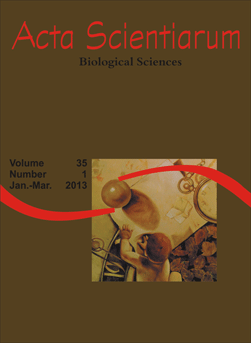<b>Morphological aspects of the salivary glands of Crab-eating racoon (<i>Procyon cancrivorus</i>)</b> - doi: 10.4025/actascibiolsci.v35i1.12675
Resumo
Procyon cancrivorus is a wild mammal from the Procyonidae family, being one of the least studied Brazilian carnivores. The aim of this study was to describe the morphological aspects of the salivary glands of Procyon cancrivorus, and to compare with literature data on the morphology of domestic animals and wilds animals, such as coatis and possums. Three adult animals were collected on highways (roadkilled), fixed 10% formaldehyde aqueous solution and submitted to desiccation. The salivary glands of the crab-eating raccoon are formed by the parotid, mandibular, sublingual and zygomatic glands. The parotid gland shows irregularly triangular shape with its respective duct. The mandible gland shows rounded outline surrounded by a fibrous capsule with its respective duct. The sublingual gland is divided into two parts: the caudal part, located in the occiptomandibular region of the digastric muscle and the rostral part between the tunica mucosa of the mouth and the mylohyoid muscle with its respective duct. The zygomatic gland is small and rounded, located in the rostral part of the pterygopalatine fossa with its respective duct. The morphology of the salivary glands of crab-eating raccoon presents great similarity in shape and arrangement with the glands of dog, cat, coatis and possum.
Downloads
DECLARAÇÃO DE ORIGINALIDADE E DIREITOS AUTORAIS
Declaro que o presente artigo é original, não tendo sido submetido à publicação em qualquer outro periódico nacional ou internacional, quer seja em parte ou em sua totalidade.
Os direitos autorais pertencem exclusivamente aos autores. Os direitos de licenciamento utilizados pelo periódico é a licença Creative Commons Attribution 4.0 (CC BY 4.0): são permitidos o compartilhamento (cópia e distribuição do material em qualqer meio ou formato) e adaptação (remix, transformação e criação de material a partir do conteúdo assim licenciado para quaisquer fins, inclusive comerciais.
Recomenda-se a leitura desse link para maiores informações sobre o tema: fornecimento de créditos e referências de forma correta, entre outros detalhes cruciais para uso adequado do material licenciado.












1.png)




3.png)













